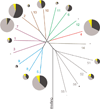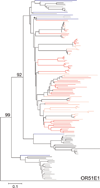Update on the olfactory receptor (OR) gene superfamily
- PMID: 19129093
- PMCID: PMC2752031
- DOI: 10.1186/1479-7364-3-1-87
Update on the olfactory receptor (OR) gene superfamily
Abstract
The olfactory receptor gene (OR) superfamily is the largest in the human genome. The superfamily contains 390 putatively functional genes and 465 pseudogenes arranged into 18 gene families and 300 subfamilies. Even members within the same subfamily are often located on different chromosomes. OR genes are located on all autosomes except chromosome 20, plus the X chromosome but not the Y chromosome. The gene:pseudogene ratio is lowest in human, higher in chimpanzee and highest in rat and mouse--most likely reflecting the greater need of olfaction for survival in the rodent than in the human. The OR genes undergo allelic exclusion, each sensory neurone expressing usually only one odourant receptor allele; the mechanism by which this phenomenon is regulated is not yet understood. The nomenclature system (based on evolutionary divergence of genes into families and subfamilies of the OR gene superfamily) has been designed similarly to that originally used for the CYP gene superfamily.
Figures


References
-
- Dayhoff MO, Barker WC, Hunt LT. Establishing homologies in protein sequences. Methods Enzymol. 1983;91:524–545. - PubMed
Publication types
MeSH terms
Substances
Grants and funding
LinkOut - more resources
Full Text Sources
Other Literature Sources

